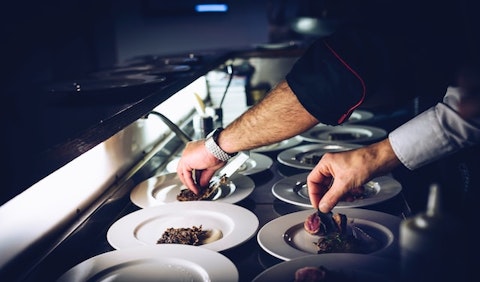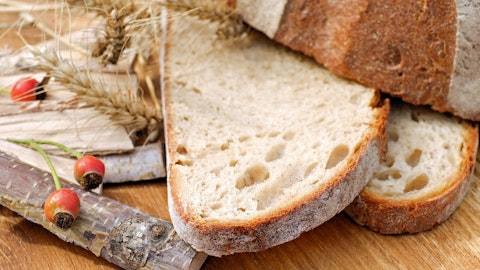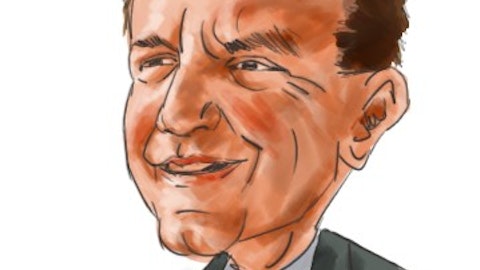Lancaster Colony Corporation (NASDAQ:LANC) Q2 2023 Earnings Call Transcript February 2, 2023
Operator: Good morning. My name is Anita, and I will be your conference call facilitator today. At this time, I would like to welcome everyone to the Lancaster Colony Corporation Fiscal Year 2023 Second Quarter Conference Call. Conducting today’s call will be David Ciesinski, President and CEO; and Tom Pigott, CFO. All lines have been placed on mute to prevent any background noise. After the speakers have completed their prepared remarks, there will be a question-and-answer period Thank you. And now to begin the conference call here is Dale Ganobsik, Vice President of Corporate Finance and Investor Relations for Lancaster Colony Corporation.
Dale Ganobsik: Good morning, everyone, and thank you for joining us today for Lancaster Colony’s Fiscal Year 2023 Second Quarter Conference Call. Our discussion this morning may include forward-looking statements, which are subject to the Safe Harbor provisions of the Private Securities Litigation Reform Act of 1995. These statements are subject to a number of risks and uncertainties that could cause actual results to differ materially, and the company undertakes no obligation to update these statements based upon subsequent events. A detailed discussion of these risks and uncertainties is contained in the company’s filings with the SEC. Also note that, the audio replay of this call will be archived and available on our company’s website lancastercolony.com later this afternoon.
For today’s call, Dave Ciesinski, our President and CEO will begin with the business update and highlights for the quarter. Tom Pigott our CFO will then provide an overview of the financial results. Dave will then share some comments regarding our current strategy and outlook. At the conclusion of our prepared remarks, we’ll be happy to respond to any of your questions. Once again, we appreciate your participation this morning. I’ll now turn the call over to Lancaster Colony’s President and CEO, Dave Ciesinski. Dave?
David Ciesinski: Thanks, Dale, and good morning, everyone. It’s a pleasure to be here with you today as we review our second quarter results for fiscal year 2023. In our fiscal second quarter, which ended December 31, we were pleased to report both record sales and higher profits. Consolidated net sales increased 11.4% to $477 million, while consolidated gross profit improved 5.7% to $102.1 million, and operating income grew 13.3% to $51.3 million. The Retail segment’s second quarter net sales reached $259 million, up 5.6%, including the favorable impact of the pricing actions we have taken to offset inflationary costs. Beyond pricing, sales gains were driven by New York Bakery frozen garlic bread, and the continued success of our licensing program.
The growth of licensed sauces was led by Buffalo Wild Wings and incremental sales from the recently launched Arby’s Horsey and Arby’s Sauces. Retail segment sales volumes measured in pounds were up 3.8% in the period, due to price elasticity as anticipated, along with the impact of our decision to exit some less profitable product line in fiscal 2022. IRI data for the second quarter showed very strong performance for our marquee retail brands. Sister Schubert’s leading share of the frozen dinner roll category increased 140 basis points to 55.4%. Marzetti share of the refrigerated salad dressing category added 110 basis points to 23.7%. And New York Bakery’s leading share of the frozen garlic bread category grew 90 points to 43.1%. In summary, the Q2 top line results for our Retail segment reflect our pricing actions, strong share growth from our core retail brands, and contributions from our licensing program, which were partially offset by price elasticity and product line rationalizations.
In our Foodservice segment, net sales grew over 19% driven our pricing actions along with volume gains for select customers and our mix of national accounts. Foodservice volume was down 4.6% in the quarter, primarily driven by our decision to exit some less profitable product lines in fiscal 2022. During Q2, we continue to experience high level of inflation for raw materials, packaging and freight. That said, we’ve made great progress through our pricing actions to where our PNOC or pricing net of commodities was favorable versus the prior year. This is a continuation of the trend that began in Q1 in which we are recovering some of the negative PNOC we experienced last year. In the quarters ahead, we intend to focus on productivity gains in our supply chain and revenue growth management to improve our financial performance.
Before I turn it over to Tom, I would like to extend my sincere thanks to the entire Lancaster Colony team, for all their ongoing commitment and contributions to our improved operational and financial performance. I’ll now turn the call over to Tom, our Chief Financial Officer, for his commentary on our second quarter results. Tom?
Tom Pigott: Thanks, Dave. Overall, the results for the quarter reflected continued top and bottom-line growth driven by pricing actions that offset inflationary costs, as well as improved fundamentals. First quarter consolidated net sales increased by 11.4% to $477.4 million. This growth was driven by successfully implemented pricing actions, in both segments. Decomposing the 11.4% revenue growth,15.4 percentage points were driven by pricing, the impact of the volume decline Dave mentioned, was four percentage points. Consolidated gross profit increased by $5.5 million or 5.7% to $102.1 million. Gross profit margin declined by 110 basis points, reflecting the dilutive impact of higher pricing and commodity costs on the percentage calculation.

Photo by Fabrizio Magoni on Unsplash
The increase in gross profit dollars reflects favorable pricing net of commodities or PNOC in both segments. If you will recall, in Q2 of fiscal 2022, we had negative PNOC, as we lagged the rapid run-up in costs. We continue to recover those losses. While our commodity inflation was about approximately 24% this quarter, our pricing actions offset this increase and the majority of the prior year shortfall resulting in the improved performance. Consistent with the first quarter, our results also reflected improved fundamentals in three areas. First, both of our segments have eliminated lower profit businesses and SKUs. Second, through improved planning, scheduling and tactical execution, factory headcount was down for the quarter versus the prior year quarter.
Third, inventory days on hand are down versus the prior year quarter and our mix of inventory is better aligned with demand trends. These items along with a more stable and predictable operating environment, helped to improve gross profit and significantly improve our cash flow performance. Selling, general and administrative expenses declined 1.5% or $800,000. This decrease was primarily due to lower expenditures on Project Ascent. Expenditures for Project Ascent, our ERP initiative totaled $7.5 million in the current year quarter versus $8.6 million in the prior year quarter. We also benefited from lower professional fees and timing-related changes in consumer spending. Consolidated operating income increased $6 million or 13.3% to $51.3 million, primarily due to the gross profit growth and the reduction in SG&A costs.
In the prior year quarter, we had a change in contingent consideration and a restructuring charge. The net impact of these items was immaterial. Our tax rate for the quarter was 22.8% versus 24.3% in the prior year quarter. We estimate our tax rate for the remainder of fiscal year 2023 to be 23%. Second quarter diluted earnings per share increased, $0.20 to $1.45. The increase was primarily driven by the growth in operating income. With regard to capital expenditures, payments for property additions in the second quarter totaled $31.9 million. For fiscal year 2023, we are forecasting total capital expenditures of approximately $100 million. This forecast includes approximately $50 million for the completion of the Horse Cave, expansion project.
In addition, to investing in our business, we also returned funds to shareholders. Our quarterly cash dividend of $0.85 per share on December 30 represented, a 6% increase from the prior year amount. Our enduring streak of annual dividend increases now stands at 60 years. Our financial position remains strong, as we’re debt free with $95.5 million of cash on balance sheet. So, to wrap up my commentary, our second quarter results reflect revenue growth driven by pricing that served to offset significant commodity inflation. In addition, the company continued to execute well on the fundamentals in a more stable operating environment. I’ll now turn it back over to Dave, for his closing remarks. Thank you.
David Ciesinski: Thanks Tom. As we look ahead, Lancaster Colony will continue to leverage the combined strength of our team, our operating strategy and our balance sheet in support of the three simple pillars of our growth plan to one, accelerate core business growth; number two, to simplify our supply chain to reduce our cost and grow our margins; and three, to expand our core with focused M&A and strategic licensing. In our fiscal third quarter, we expect Retail sales to benefit from our expanding licensing program while in the Foodservice segment we anticipate continued volume growth from some of our QSR customers. Cost inflation will remain a headwind for our financial results, but we expect our pricing actions and cost savings initiatives to offset the increased cost.
During our fiscal third quarter, we will also continue to ramp up the production in the newly expanded section of our dressing and sauce facility in Horse Cave, Kentucky. In the back half of our fiscal year, SG&A costs will reflect increased investments in our business including higher levels for spend on consumer promotions. We will also continue to monitor economic conditions for any potential impact on our Foodservice business. Finally, I’d like to provide you with an update on the implementation phase of our ERP initiative, Project Ascent. As we shared previously this past July we successfully completed Wave 1 of the implementation. And in October, we completed Wave 2. We are now in the early days of the third wave of implementation, which will add our dressing and sauce production facility in Horse Cave, Kentucky to the new system.
As many of you are aware this facility is the largest plant in our manufacturing network. All is proceeding as planned and we look forward to completing this important phase of Project Ascent. Note that during the implementation phase, we will have this facility down for four days as part of the cutover process. Our third quarter financial results will reflect the incremental costs associated with this temporary shutdown. I would like to extend my sincere thanks to my teammates for their ongoing efforts on this very important strategic initiative. This concludes our prepared remarks for today and we’d be happy to answer any questions that you might have. Operator?
See also 10 Hot Insurance Stocks To Buy Now and 15 Best Dividend Leaders to Buy .
Q&A Session
Follow Lancaster Colony Corp (NASDAQ:LANC)
Follow Lancaster Colony Corp (NASDAQ:LANC)
Operator: Thank you. Our first question today comes from Andrew Wolf with CL King. Please go ahead.
Andrew Wolf: Thank you. Good morning. I wanted to
David Ciesinski: Good morning.
Andrew Wolf: Hi. Thank you. On volume there was like — it improved. I mean, volumes were still down, but they improved a lot nicely for retail. And I saw that your direct-to-consumer or your consumer marketing was down, but how about the promotion that is accounted for as a net reduction of sales particularly trade spending or other items. Did the — could you give us a little more detail on the evolution of the improvement in volume sequentially this quarter versus last quarter? And what — did that include promoting? And did that impact the gross margin?
David Ciesinski: Yeah. It’s a great question Andrew and I’ll take it head on. So our trade spending performance during the period was essentially flat versus the prior period. And on volume if you adjust for the fact that we had discontinuations in the prior period that we’re continuing to work our way through, our volume — discontinuations was down 1.9%. And I think when you pull it apart and you look at it across Retail and Foodservice, I’ll hit them sequentially, our Retail business remains strong. The business continues to perform very much in line with our elasticities. We posted record shares in New York Texas Toast and we posted record shares in Sister Schubert’s as well. Our Marzetti brand and refrigerated dressing continue to do well.
And the licensed sauces we’ve told you before are a bit unique in that it’s — they don’t have necessarily the direct competitors on the shelf. So vis-Ã -vis the magnitude of the price increases we feel very good about the volume that we have that’s in there and the performance. Now swinging around to Foodservice. Here again I would say that we’re seeing — we’re optimistic about what we’re seeing. So traffic across the whole industry was essentially flat in the period. And that was marginally better than it was in the preceding quarter. And if you look at our mix of customers, it reflects that. We had several customers Chick-fil-A first among them that were growing traffic. Taco Bell was also strong. Olive Garden was strong. But there were some others in the space that were a little softer.
But what continues to give us a measure of optimism when we look at volume is that our elasticities in Retail are performing in line with our expectation. And really, we have our new items that are back-half loaded, as we’ve shared with you guys throughout the period, this fiscal year-to-date. And in Foodservice, I would tell you the same thing. We remain cautiously optimistic about the consumer, and we have LTO activity that’s planned in the back half. So net-net, we think our volume is holding up in line to slightly better than our expectations at the beginning of the year.
Andrew Wolf: Thank you. That was a pretty full explanation. So on the gross margin specifically, are there any things in there to call out with regard to getting Horse Cave up and running? Is there some — obviously when Horse Cave is running whenever that is sometime in the future that will have an impact that I’d like to know about too. But particularly in the quarter, was there any disruption there? And…
David Ciesinski: No.
Andrew Wolf: Go ahead. Yeah.





